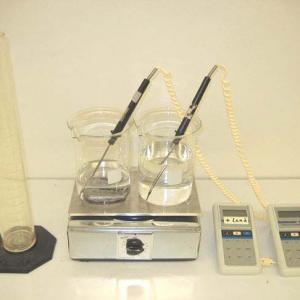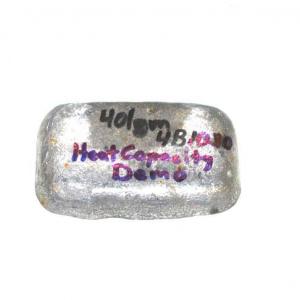College of Liberal Arts & Sciences
4B10.10 - Heat Capacity Demo
Set the demo up using 800 ml of water in one beaker. Use 400 grams of lead and 400 ml of water in the other beaker. Heat and observe that the beaker with the lead will have a faster rise in temperature.
- William A. (Toby) Dittrich, "Drop Tower Physics", TPT, Vol. 52, #7, Oct. 2014, p. 415.
- Trevor C. Lipscombe, Carl E. Mungan, "The Physics of Shot Towers", TPT, Vol. 50, # 4, Apr. 2012, p. 218.
- "Figuring Physics", TPT, Vol. 47, # 5, May 2009, p. 309.
- Francisco Glover, "Specific Heat Capacity - A Quantum Explanation", TPT, Vol. 7, # 3, March 1969, p. 149.
- Hb- 2: Freier and Anderson, A Demonstration Handbook for Physics.
- Tik Liem, "The Hot Bolt", Investigation to Science Inquiry, p. 179.
Disclaimer: These demonstrations are provided only for illustrative use by persons affiliated with The University of Iowa and only under the direction of a trained instructor or physicist. The University of Iowa is not responsible for demonstrations performed by those using their own equipment or who choose to use this reference material for their own purpose. The demonstrations included here are within the public domain and can be found in materials contained in libraries, bookstores, and through electronic sources. Performing all or any portion of any of these demonstrations, with or without revisions not depicted here entails inherent risks. These risks include, without limitation, bodily injury (and possibly death), including risks to health that may be temporary or permanent and that may exacerbate a pre-existing medical condition; and property loss or damage. Anyone performing any part of these demonstrations, even with revisions, knowingly and voluntarily assumes all risks associated with them.


